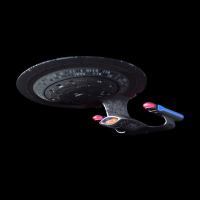It’s a classic, if somewhat exaggerated trope in Star Trek: The ships first officer, second officer, tactical officer, chief engineer, chief medical officer, and a random ensign beam down to an unsecured planet while some dangerous problem is either ongoing or likely to occur. The Doylist reasons for this are as obvious as the Watsonian reasons it seems so silly: these are the main characters who are supposed to get the bulk of the screen time, so they are constantly thrown into situations which real world commanding officers and department heads are generally kept well clear of.
But what if this wasn’t the precedent established in TOS and continued in every subsequent series (including, to a slightly lesser but very real extent, Lower Decks)? What would a Star Trek show look like which still had senior officers who we are meant to care about and who still get significant development and screen time, but who aren’t thrown into unrealistically dangerous situations on a regular basis? Could such a show survive telling stories without visibly putting those regulars lives on the line so frequently? Would it be viable to keep the focus on things that happen either aboard ship or in nominally safe situations? Alternately, could a show successfully develop a cast of lower ranking “away team” characters who get the “dangerous” screen time while keeping significant focus on the major decision makers on the bridge? And how could the shows manage such a visible separation between “expendable” and “not expendable” crew while maintaining that humanist, optimistic, everybody-has-an-equal-right-to-life ethos?
It wouldn’t be an easy thing to pull off, certainly. But how could it have been done?


This can work out great for streaming…and solve the “short show problem”. Make TWO shows for each setting. So you’d have, for example, Star Trek: Explorer A and Star Trek Explorer B.
Star Trek: Explorer A would be the command staff, but they would not go ‘away’ much and would have much more administrative roles. Still plenty of action and adventure, but more “cerebral”.
Star Trek: Explorer B would be the middle ranks, and the ones that go on the away missions. They dodge ray beams, fight aliens and all that stuff.
Each show would be “made” independently, but they would use the same sets (ohh, saves money) and each of the casts could guest star on the other show sometimes.
And…with good writing EACH episode is BOTH a stand alone episode AND a two part episode. So you don’t “need” to watch both episodes to get the story…but the story is enhanced if you do.
To use TNG as an example for know characters:
Star Trek A: The Enterprise goes to Ceti Beta Cappa Seven. A Federation world that has developed a new AI that the government of the planet is obeying blindly as they think it is ‘the best’. But now the AI has ordered the killing of the blue skinned subrace. So this is Picard, Riker, Troi and Crusher talking and negotiation with the officials. To not blindly follow the AI and think for themselves. Data adds in the ‘planet AI’ is not 'alive, like him". Worf shows how instincts and nature is important. At the end they convince the government to destroy the AI and go back to normal. Our B cast guest stars for two minutes as they leave to go to the offical reception on the planet.
Star Trek B - The ship arrives at the planet ‘seven’, and the A cast get short ‘send offs’ to the B crew: Lieutenant Commander Nella Daren ,Lieutenant Sandra Rhodes, Lieutenant Diana Giddings, and Lieutenant, B.G. Robinson. On the planet they go to the celebration…get caught by the rebels (while ‘the ship thinks they are out parting’) and have to fight the AI. Then they find out the government want to turn off the AI(see other episode…)…but it’s fighting back. So they help…and save the day.